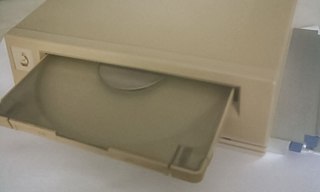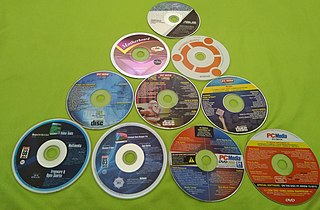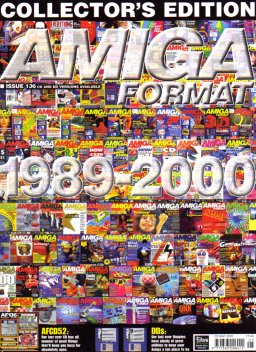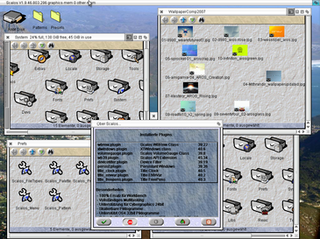
Amiga is a family of personal computers introduced by Commodore in 1985. The original model is one of a number of mid-1980s computers with 16- or 16/32-bit processors, 256 KB or more of RAM, mouse-based GUIs, and significantly improved graphics and audio compared to previous 8-bit systems. These systems include the Atari ST—released earlier the same year—as well as the Macintosh and Acorn Archimedes. Based on the Motorola 68000 microprocessor, the Amiga differs from its contemporaries through the inclusion of custom hardware to accelerate graphics and sound, including sprites and a blitter, and a pre-emptive multitasking operating system called AmigaOS.

A bulletin board system (BBS), also called a computer bulletin board service (CBBS), is a computer server running software that allows users to connect to the system using a terminal program. Once logged in, the user can perform functions such as uploading and downloading software and data, reading news and bulletins, and exchanging messages with other users through public message boards and sometimes via direct chatting. In the early 1980s, message networks such as FidoNet were developed to provide services such as NetMail, which is similar to internet-based email.
AmigaGuide is a hypertext document file format designed for the Amiga. Files are stored in ASCII so it is possible to read and edit a file without the need for special software.
AmigaDOS is the disk operating system of the AmigaOS, which includes file systems, file and directory manipulation, the command-line interface, and file redirection.

The Amiga A570 is a single-speed external CD-ROM drive for the Amiga 500 computer launched by Commodore in 1992. It was designed to be compatible with Commodore CDTV software as well as being able to read ordinary ISO 9660 CD-ROM discs.

Covermount is the name given to storage media or other products packaged as part of a magazine or newspaper. The name comes from the method of packaging; the media or product is placed in a transparent plastic sleeve and mounted on the cover of the magazine with adhesive tape or glue.
Aminet is the world's largest archive of Amiga-related software and files. Aminet was originally hosted by several universities' FTP sites, and is now available on CD-ROM and on the web. According to Aminet, as of 3 September 2022, it has 83930 packages online.

A disk magazine, colloquially known as a diskmag or diskzine, is a magazine that is distributed in electronic form to be read using computers. These had some popularity in the 1980s and 1990s as periodicals distributed on floppy disk, hence their name. The rise of the Internet in the late 1990s caused them to be superseded almost entirely by online publications, which are sometimes still called "diskmags" despite the lack of physical disks.

Compunet was a United Kingdom-based interactive service provider, catering primarily for the Commodore 64 but later for the Amiga and Atari ST. It was also known by its users as CNet. It ran from 1984 to May 1993.

Amiga Format was a British computer magazine for Amiga computers, published by Future plc. The magazine lasted 136 issues from 1989 to 2000. The magazine was formed when, in the wake of selling ACE to EMAP, Future split the dual-format title ST/Amiga Format into two separate publications. At the height of its success the magazines sold over 170,000 copies per month, topping 200,000 with its most successful ever issue.
Amiga software is computer software engineered to run on the Amiga personal computer. Amiga software covers many applications, including productivity, digital art, games, commercial, freeware and hobbyist products. The market was active in the late 1980s and early 1990s but then dwindled. Most Amiga products were originally created directly for the Amiga computer, and were not ported from other platforms.
Skypix is the name of a markup language used to encode graphics content such as changeable fonts, mouse-controlled actions, animations and sound to bulletin board system. The system was written by Michael Cox on the Amiga in 1987, and first hosted on the Atredes BBS system, which was later renamed Skyline. Skypix allowed BBS sysops to create interactive BBS systems with graphics, fonts, mouse-controlled actions, animations and sound.
AmigaOS is the proprietary native operating system of the Amiga personal computer. Since its introduction with the launch of the Amiga 1000 in 1985, there have been four major versions and several minor revisions of the operating system.

AmigaOS 4 is a line of Amiga operating systems which runs on PowerPC microprocessors. It is mainly based on AmigaOS 3.1 source code developed by Commodore, and partially on version 3.9 developed by Haage & Partner. "The Final Update" was released on 24 December 2006 after five years of development by the Belgian company Hyperion Entertainment under license from Amiga, Inc. for AmigaOne registered users.
Amiga support and maintenance software performs service functions such as formatting media for a specific filesystem, diagnosing failures that occur on formatted media, data recovery after media failure, and installation of new software for the Amiga family of personal computers—as opposed to application software, which performs business, education, and recreation functions.
Kickstart is the bootstrap firmware of the Amiga computers developed by Commodore International. Its purpose is to initialize the Amiga hardware and core components of AmigaOS and then attempt to boot from a bootable volume, such as a floppy disk. Most Amiga models were shipped with the Kickstart firmware stored on ROM chips.

AmigaOS is a family of proprietary native operating systems of the Amiga and AmigaOne personal computers. It was developed first by Commodore International and introduced with the launch of the first Amiga, the Amiga 1000, in 1985. Early versions of AmigaOS required the Motorola 68000 series of 16-bit and 32-bit microprocessors. Later versions were developed by Haage & Partner and then Hyperion Entertainment. A PowerPC microprocessor is required for the most recent release, AmigaOS 4.

Scalos is a desktop replacement for the original Amiga Workbench GUI, based on a subset of APIs and its own front-end window manager of the same name. Scalos is NOT an AmigaOS replacement, although its name suggests otherwise. Its goal is to emulate the real Workbench behaviour, plus integrating additional functionality and an enhanced look. As stated on its website, the name "Scalos" was inspired by the fictional time-accelerated planet Scalos in the Star Trek episode "Wink of an Eye".
This article deals with programming languages used in the Amiga line of computers, running the AmigaOS operating system and its derivatives AROS and MorphOS. It is a split of the main article Amiga software. See also related articles Amiga productivity software, Amiga music software, Amiga Internet and communications software and Amiga support and maintenance software for other information regarding software that runs on Amiga.
Retargetable graphics is a device driver API mainly used by third-party graphics hardware to interface with AmigaOS via a set of libraries. The software libraries may include software tools to adjust resolution, screen colors, pointers, and screenmodes. It will use available hardware and will not extend the capabilities in any way.









